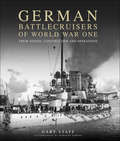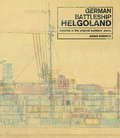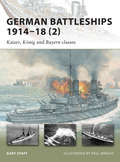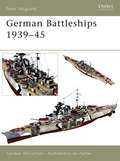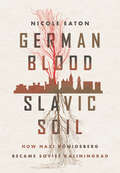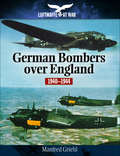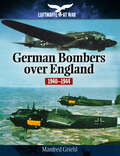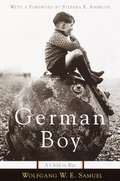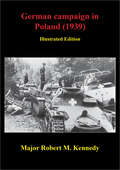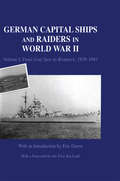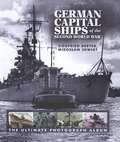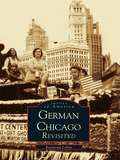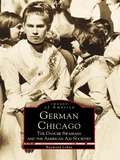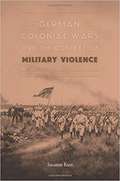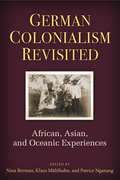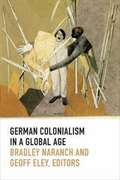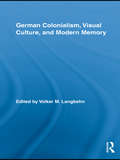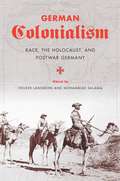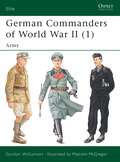- Table View
- List View
German Battlecruisers of World War One: Their Design, Construction And Operations
by Gary StaffThis is the most comprehensive study yet in the English language of the German Imperial Navy's battlecruisers that served in the First World War. Known as Panzerkreuzer, literally 'armoured cruiser', the eight ships of the class were to be involved in several early North Sea skirmishes before the great pitched battle of Jutland where they inflicted devastating damage on the Royal Navy's battlecruiser fleet.In this new book the author details their design and construction, and traces the full service history of each ship, recounting their actions, largely from first-hand German sources and official documents, many previously unpublished in English. Detailed line drawings and maps augment the text throughout, as do a wealth of contemporary photos that depict the vessels at sea as well as in dock, where details of damage sustained in action and many aspects of their design can be viewed in close up. A superb series of full-colour, specially-commissioned computer graphics show full length profiles and top-down views of each ship in precise and clear detail. This stunning book is a major new contribution to German naval history in this country and will become a 'must-have' volume on the shelves of historians, enthusiasts and modellers and indeed for anyone interested in the navies of the First World War and steel warships in general.
German Battleship Helgoland: As Detailed in the Original Builders' Plans
by Aidan DodsonThis volume presents complete and annotated facsimiles of the official builders&’ plans for Germany&’s WWI era dreadnaught battleship, SMS Helgoland. Launched in 1909, SMS Helgoland was the lead battleship in her class and represented a major improvement over the earlier Westfalen class. Helgoland featured 12-inch guns, matching those of her British counterparts, and served in the German Imperial Navy&’s High Seas Fleet throughout the First World War. She fought in the Battle of Jutland, was ceded to Britain as part of the peace terms and was broken up in 1924. The official builders&’ plans are now preserved by the National Maritime Museum in Greenwich, England. Using the latest scanning technology to make digital copies of the highest quality, this volume reproduces the complete set of documents in full color, with many close-ups and enlargements that make every aspect clear and comprehensible. Extensive captions point the reader to important features to be found in the plans, and an introduction covers the background to the design. The result is a supremely authoritative reference that will be a revelation to any warship enthusiast.
German Battleships 1914-18
by Paul Wright Gary StaffSupported by official documents, personal accounts, official drawings and specially commissioned artwork, this volume is an enlightening history of the key classes of Kaiser, K¿nig and Bayern that formed the backbone of the German Imperial Navy throughout World War I. It details the technological revolution that had taken place to ensure the building of these largest dreadnought classes, in particular the developments in size and armament as well as the steps taken to prevent battle damage as Germany readied herself for war. This account of design and technology is supplemented by individual ship histories detailing combat experience complete with first-hand accounts. The specially commissioned artwork also brings this history to life with a cutaway recreation of the fleet's flagship and the Battle of Moon Sound in the Baltic in 1917 where the battleship Konig caused the destruction of the Russian battleship Slava.
German Battleships 1939-45
by Ian Palmer Gordon WilliamsonIn this, the first of a five volume series covering the capital ships of the German Navy of World War II, Gordon Williamson examines the design, development and operational use of the battleships used by the Kriegsmarine. The 'Schlesien' and 'Schleswig-Hostein' were used mostly as training ships until the end of the war when they took part in bombardment of Soviet troop movements in East Prussia. The 'Scharnhorst' had a successful career until her sinking at the battle of the North Cape, and the 'Gneisenau' with her ignominious end as a block-ship. Bismarck's short but glorious career and Tirpitz's lonely vigil in Norway's distant Fjords until sunk by RAF bombers using the massive 'Tallboy' bombs are also covered.
German Blood, Slavic Soil: How Nazi Königsberg Became Soviet Kaliningrad (Battlegrounds: Cornell Studies in Military History)
by Nicole EatonGerman Blood, Slavic Soil reveals how Nazi Germany and the Soviet Union, twentieth-century Europe's two most violent revolutionary regimes, transformed a single city and the people who lived there. During World War II, this single city became an epicenter in the apocalyptic battle between their two regimes.Drawing on sources and perspectives from both sides, Nicole Eaton explores not only what Germans and Soviets thought about each other, but also how the war brought them together. She details an intricate timeline, first describing how Königsberg, a seven-hundred-year-old German port city on the Baltic Sea and lifelong home of Immanuel Kant, became infamous in the 1930s as the easternmost bastion of Hitler's Third Reich and the launching point for the Nazis' genocidal war in the East. She then describes how, after being destroyed by bombing and siege warfare in 1945, Königsberg became Kaliningrad, the westernmost city of Stalin's Soviet Union. Königsberg/Kaliningrad is the only city to have been ruled by both Hitler and Stalin as their own—in both wartime occupation and as integral territory of the two regimes. German Blood, Slavic Soil presents an intimate look into the Nazi-Soviet encounter during World War II. Eaton impressively shows how this outpost city, far from the centers of power in Moscow and Berlin, became a closed-off space where Nazis and Stalinists each staged radical experiments in societal transformation and were forced to reimagine their utopias in dialogue with the encounter between the victims and proponents of the two regimes.
German Bombers Over England, 1940–1944 (Luftwaffe at War)
by Manfred GriehlGerman Bombers over England is a unique and valuable pictorial guide to Germany's bomber force. The author has drawn on his own archive to present rare pictures of the German bombers and their crew, while detailed captions examine their role in preparations for Operation Sea Lion in 1940 through to the very last V1 and V2 rocket bomb missions in the closing stages of the war.
German Bombers Over England, 1940–1944 (Luftwaffe at War)
by Manfred GriehlGerman Bombers over England is a unique and valuable pictorial guide to Germany's bomber force. The author has drawn on his own archive to present rare pictures of the German bombers and their crew, while detailed captions examine their role in preparations for Operation Sea Lion in 1940 through to the very last V1 and V2 rocket bomb missions in the closing stages of the war.
German Boy: A Child in War
by Stephen E. Ambrose Wolfgang W. E. Samuel“I think German Boy has all the qualities of greatness. I love the book. ” -- from the Foreword by Stephen Ambrose As the Third Reich crumbled in 1945, scores of Germans scrambled to flee the advancing Russian troops. Among them was a little boy named Wolfgang Samuel, who left his home with his mother and sister and ended up in war-torn Strasbourg before being forced farther west into a disease-ridden refugee camp. German Boy is the vivid, true story of their fight for survival as the tables of power turned and, for reasons Wolfgang was too young to understand, his broken family suffered arbitrary arrest, rape, hunger, and constant fear. Because his father was off fighting the war as a Luftwaffe officer, young Wolfgang was forced to become the head of his household, scavenging for provisions and scraps with which to feed his family. Despite his best efforts, his mother still found herself forced to do the unthinkable to survive, and her sacrifices became Wolfgang’s worst nightmares. Somehow, with the resilience only children can muster, he maintained his youth and innocence in little ways–making friends with other young refugees, playing games with shrapnel, delighting in the planes flown by the Americans and the candies the GIs brought. In the end, the Samuels begin life anew in America, and Wolfgang eventually goes on to a thirty-year career in the U. S. Air Force. Bringing fresh insight to the dark history of Nazi Germany and the horror left in its wake, German Boy records the valuable recollections of an innocent’s incredible journey.
German Boy: A Refugee’s Story (Willie Morris Books in Memoir and Biography)
by Colonel Wolfgang W. SamuelWhat was the experience of war for a child in bombed and ravaged Germany? In this memoir, the voice of innocence is heard. “This is great stuff,” exclaims Stephen E. Ambrose. “I love this book.” In this gripping account, a boy and his mother are wrenched from their tranquil lives to forge a path through the storm of war and the rubble of its aftermath. In the past there has been a spectrum of books and films that share other German World War II experiences. However, told from the perspective of a ten-year-old, this book is rare. The boy and his mother must prevail over hunger and despair, or die. In the Third Reich, young Wolfgang Samuel and his family are content but alone. The father, a Luftwaffe officer, is away fighting the Allies in the West. In 1945 as Berlin and nearby communities crumble, young Wolfgang, his mother Hedy, and little sister Ingrid flee the advancing Russian army. They have no inkling of the chaos ahead. In Strasburg, a small town north of Berlin where they find refuge, Wolfgang begins to comprehend the evils the Nazi regime brought to Germany. As the Reich collapses, mother, son, and daughter flee again just ahead of the Russian charge. In the chaos of defeat they struggle to find food and shelter. Death stalks the primitive camps that are their temporary havens, and the child becomes the family provider. Under the crushing responsibility, Wolfgang becomes his mother’s and sister’s mainstay. When they return to Strasburg, the Communists in control are as brutal as the Nazis. In the violent atmosphere of arbitrary arrest, rape, hunger, and fear, the boy and his mother persist. Pursued by Communist police through a fierce blizzard, they escape to the West, but even in the English zone, the constant search for food, warmth, and shelter dominates their lives, and the mother’s sacrifices become the boy’s nightmares. Although this is a time of deepest despair, Wolfgang hangs on to the thinnest thread of hope. In June 1948 with the arrival of the Americans flying the Berlin Airlift, Wolfgang begins a new journey.
German Campaign In Poland (1939) [Illustrated Edition]
by Major Robert M. KennedyIncludes 6 maps and over 20 other illustrationsThe German attack on Poland precipitated World War II, making the Polish campaign one of particular significance to the student of the 1939-45 conflict. The lessons learned by the German Army in its operations in Poland were put to use in the later campaigns against the western Allies, the Balkan states, and the Soviet Union. Poland also formed the testing ground for new theories on the use of armored forces and close air support of ground troops. The complete destruction of the Polish state and the removal of Poland from the map of eastern Europe were grim portents of the fate of the vanquished in the new concept of total war. The purpose of this campaign study is to provide the United States Army with a factual account of German military operations against Poland, based on source material from captured records currently in the custody of The Adjutant General, Department of the Army; monographs prepared by a number of former German officers for the Historical Division, United States Army, Europe; and such Polish accounts as were available.
German Capital Ships and Raiders in World War II: Volume I: From Graf Spee to Bismarck, 1939-1941 (Naval Staff Histories #Vol. Ii)
by Eric GroveThis is a comnpendium volume of three Battle Summaries or Naval Staff Histories produced soon after the war by the Naval Historical Branch of the Admiralty. Originally classified and designed for internal use only, these histories are published here for the first time. The documents in this book cover the actions during the period 1939-1941 that resulted in the sinking or immobilising of the German Warships Birsmark and Graf Spee, and record the struggle to rid the seas of the menace of the armed merchants raiders.
German Capital Ships of the Second World War: The Ultimate Photograph Album
by Miroslaw Skwiot Siegfried Breyer&“Outstanding . . . covers the major units starting with the Deutschland Class, through the Scharnhorst and Gneisenau, to the Bismarck and Tirpitz.&” —WW2 Cruisers The Kriegsmarine&’s capital ships—Deutschland, Admiral Scheer, Graf Spee, Scharnhorst, Gneisenau, Bismarck, and Tirpitz—continue to generate intense interest among warship enthusiasts, despite the fact that no new source of information has been unearthed in decades. What has come to light, however, is a growing number of photographs, many from private albums and some that lay forgotten in obscure archives. These include many close-ups and onboard shots of great value to modelmakers, as well as rare action photos taken during wartime operations. This book is a careful selection of the best of these, but on a grand scale, with around one hundred images devoted to each ship, allowing in-depth coverage of its whole career, from launching and fitting out to whatever fate the war had waiting for it. For sake of completeness, there are even sections reproducing the various design studies that led to each class, while an appendix covers the uncompleted Graf Zeppelin, Germany&’s only attempt to build an aircraft carrier, the vessel which clearly displaced the battleship as the capital ship of the world&’s navies during the war. Essays on technical backgrounds and design origins by the well-known expert Siegfried Breyer and explanatory captions by Miroslaw Skwiot draw out the full significance of this magnificent collection of photos. &“Highly recommended for those who wish to admire seven of the most magnificent warships built anywhere in the twentieth century. We will certainly never see their like again.&” —Journal of the Australian Naval Institute
German Chicago: Revisited (Images of America)
by Raymond LohneGerman Chicago Revisited follows the photographic study which began in German Chicago: The Danube Swabians and the American Aid Societies. With this latest title in the Images of America series, historian and photographer Raymond Lohne crafts another volume about a group of American citizens who preserve their rich heritage with unwavering effort.This book will give readers a glimpse into the life of a close-knit and highly active community, revealing groups like the Kerneir Pleasure Club, the American Aid Society, and the Society of the Danube Swabians. The German musical life of the city is featured, as is the Karneval season and other year-round festivities and celebrations of the Deutsch-Americans of Chicago and its suburbs.
German Chicago: The Danube Swabians and the American Aid Societies
by Raymond LohneIn German Chicago: The Danube Swabians and the American Aid Societies, historian Raymond Lohne presents the Germans who came to be called the Donauschwaben and their American counterparts. This amazing photographic collection of over 200 historic images has been gathered through the efforts of the author and survivors of the Expulsion, as well as numerous German-American societies and individuals throughout the nation.
German Cinema - Terror and Trauma: Cultural Memory Since 1945
by Thomas ElsaesserIn German Cinema – Terror and Trauma Since 1945, Thomas Elsaesser reevaluates the meaning of the Holocaust for postwar German films and culture, while offering a reconsideration of trauma theory today. Elsaesser argues that Germany's attempts at "mastering the past" can be seen as both a failure and an achievement, making it appropriate to speak of an ongoing 'guilt management' that includes not only Germany, but Europe as a whole. In a series of case studies, which consider the work of Konrad Wolf, Alexander Kluge, Rainer Werner Fassbinder, Herbert Achterbusch and Harun Farocki, as well as films made in the new century, Elsaesser tracks the different ways the Holocaust is present in German cinema from the 1950s onwards, even when it is absent, or referenced in oblique and hyperbolic ways. Its most emphatically "absent presence" might turn out to be the compulsive afterlife of the Red Army Faction, whose acts of terror in the 1970s were a response to—as well as a reminder of—Nazism’s hold on the national imaginary. Since the end of the Cold War and 9/11, the terms of the debate around terror and trauma have shifted also in Germany, where generational memory now distributes the roles of historical agency and accountability differently. Against the background of universalized victimhood, a cinema of commemoration has, if anything, confirmed the violence that the past continues to exert on the present, in the form of missed encounters, retroactive incidents, unintended slippages and uncanny parallels, which Elsaesser—reviving the full meaning of Freud’s Fehlleistung—calls the parapractic performativity of cultural memory.
German Colonial Wars and the Context of Military Violence
by Susanne KussSome historians have traced a line from Germany’s atrocities in its colonial wars to those committed by the Nazis during WWII. Susanne Kuss dismantles these claims, rejecting the notion that a distinctive military ethos or policy of genocide guided Germany’s conduct of operations in Africa and China, despite acts of unquestionable brutality.
German Colonialism Revisited: African, Asian, And Oceanic Experiences
by Nina Berman Klaus Muehlhahn Patrice NganangGerman Colonialism Revisited brings together military historians, art historians, literary scholars, cultural theorists, and linguists to address a range of issues surrounding colonized African, Asian, and Oceanic people’s creative reactions to and interactions with German colonialism. This scholarship sheds new light on local power dynamics; agency; and economic, cultural, and social networks that preceded and, as some now argue, ultimately structured German colonial rule. Going beyond issues of resistance, these essays present colonialism as a shared event from which both the colonized and the colonizers emerged changed.
German Colonialism and National Identity (Routledge Studies in Modern European History)
by Michael PerraudinGerman colonialism is a thriving field of study. From North America to Japan, within Germany, Austria and Switzerland, scholars are increasingly applying post-colonial questions and methods to the study of Germany and its culture. However, no introduction on this emerging field of study has combined political and cultural approaches, the study of literature and art, and the examination of both metropolitan and local discourses and memories. This book will fill that gap and offer a broad prelude, of interest to any scholar and student of German history and culture as well as of colonialism in general. It will be an indispensable tool for both undergraduate and postgraduate teaching. .
German Colonialism in a Global Age
by Geoff Eley Bradley NaranchThis collection provides a comprehensive treatment of the German colonial empire and its significance. Leading scholars show not only how the colonies influenced metropolitan life and the character of German politics during the Bismarckian and Wilhelmine eras (1871-1918), but also how colonial mentalities and practices shaped later histories during the Nazi era. In introductory essays, editors Geoff Eley and Bradley Naranch survey the historiography and broad developments in the imperial imaginary of the nineteenth and twentieth centuries. Contributors then examine a range of topics, from science and the colonial state to the disciplinary constructions of Africans as colonial subjects for German administrative control. They consider the influence of imperialism on German society and culture via the mass-marketing of imperial imagery; conceptions of racial superiority in German pedagogy; and the influence of colonialism on German anti-Semitism. The collection concludes with several essays that address geopolitics and the broader impact of the German imperial experience.Contributors. Dirk Bönker, Jeff Bowersox, David Ciarlo, Sebastian Conrad, Christian S. Davis, Geoff Eley, Jennifer Jenkins, Birthe Kundus, Klaus Mühlhahn, Bradley Naranch, Deborah Neill, Heike Schmidt, J. P. Short, George Steinmetz, Dennis Sweeney, Brett M. Van Hoesen, Andrew Zimmerman
German Colonialism, Visual Culture, and Modern Memory (Routledge Studies in Modern European History)
by Volker M. LangbehnThere is no overarching master narrative in understanding the history of German colonialism, and over the past decade, the study of Germany’s colonial past has experienced a dramatic transformation in its scope of inquiry. Influenced by new theoretical and methodological approaches to the study of race, nationalism, and globalization, these new studies initiate a process of reevaluating and redefining the parameters within which German Colonialism is understood. The role of visual materials, in particular, is ideal for exploring the porousness of disciplinary boundaries, though visual culture studies pertaining to German history – and especially German colonialism – have previously been almost completely neglected. Investigating visual communication and mass culture, print culture and suggestive racial politics, racial aesthetics, racial politics and early German film, racial continuity and German film, and photography, German Colonialism, Visual Culture, and Modern Memory offers compelling evidence of a German society between 1884 and 1919 that produced vibrant and heterogeneous – and at times contradictory – cultures of colonialism. This collection of new essays illustrates the dramatic changes and vast array of perspectives that have recently emerged in the study of German colonialism. In documenting the latest cutting-edge research of German colonial history, the contributors to this volume prove wrong the persistent assumptions that the creation of Germany’s colonial empire did not have any lasting impact on German political and cultural life. Their essays document how colonialism in its various forms was entwined with the inner workings of modern German life and society, especially through the cultural and technical innovations of its time. In contrast to existing research, these studies show that colonial Germany played a significant role in shaping German perceptions of racial difference, influenced German support for World War I, and facilitated the construction of German nationalism. German Colonialism, Visual Culture, and Modern Memory uniquely demonstrates that the visual culture of colonialism is closely linked to the fascination with new modes of seeing and the enigma of visual experience that have become trademarks of modernity.
German Colonialism:
by Sebastian Conrad Sorcha O'HaganGermany was a latecomer to the colonial world of the late nineteenth century but this history of German colonialism makes clear the wide-reaching consequences of Germany's short-lived colonial project. Sebastian Conrad charts the expansion of the empire from its origins in the acquisition of substantial territories in present day Togo, Cameroon, Namibia and Tanzania to new settlements in East Asia and the Pacific and reveals the colonialist culture which permeated the German nation and its politics. Drawing on the wider history of European expansion and globalisation he highlights the close interactions and shared vocabularies of the colonial powers and emphasises Germany's major role in the period of high imperialism before 1914. Even beyond the official end of the empire in 1919 the quest for Lebensraum and the growth of the Nazi empire in Eastern Europe can be viewed within a framework of colonialism whose effects resonate to the present day.
German Colonialism: Race, the Holocaust, and Postwar Germany
by Mohammad Salama Volker LangbehnMore than half a century before the mass executions of the Holocaust, Germany devastated the peoples of southwestern Africa. While colonialism might seem marginal to German history, controversial new scholarship compares the acts of this period with Nazi practices on the Eastern and Western fronts. Examples of the most important research conducted on the "continuity thesis" over the past five years, the chapters in this anthology debate the connections between German colonialist activities and the behavior of Germany during World War II. Some argue that the country's domination of southwestern Africa gave rise to perceptions of racial difference and superiority at home, contributing to a nascent nationalism that blossomed into National Socialism and the Holocaust. Others remain skeptical, and both sides are well-represented. Contributors merge Germany's colonial past with debates over the country's identity and history and compare its colonial crimes with other European ventures. Issues discussed range from the denial or marginalization of German genocide to the place of colonialism and the Holocaust within Germany and Israel's postwar relations. Authors also compare the legacy of genocide in both Europe and Africa.
German Colonialism: Race, the Holocaust, and Postwar Germany (Routledge Studies In Modern European History Ser.)
by Mohammad Salama Eds. Langbehn VolkerMore than half a century before the mass executions of the Holocaust, Germany devastated the peoples of southwestern Africa. While colonialism might seem marginal to German history, new scholarship compares these acts to Nazi practices on the Eastern and Western fronts. With some of the most important essays from the past five years exploring the "continuity thesis," this anthology debates the links between German colonialist activities and the behavior of Germany during World War II. Some contributors argue the country's domination of southwestern Africa gave rise to perceptions of racial difference and superiority at home, building upon a nascent nationalism that blossomed into National Socialism and the Holocaust. Others remain skeptical and challenge the continuity thesis. The contributors also examine Germany's colonial past with debates over the country's identity and history and compare its colonial crimes with other European ventures. Other issues explored include the denial or marginalization of German genocide and the place of colonialism and the Holocaust within German and Israeli postwar relations.
German Combat Equipments 1939-45
by Gordon Rottman Ronald VolstadThe field equipment of the German Army in World War II was closely related to that used throughout World War I and earlier, yet it was of relatively light weight, ruggedly constructed, well designed, functional, and generally of a high quality, though this deteriorated in the later war years. A high degree of design standardisation was maintained in most categories of equipment, though materials and their colours often varied widely. There were also many different specialisations for the various arms of service as well as theatres of combat, such as the Afrikakorps in the Western Desert. This title investigates all manner of German combat equipments throughout World War II, from belt buckles to magazine pouches.
German Commanders of World War II
by Gordon Williamson Malcolm McgregorThis first of two studies examines the careers and illustrates the appearance and uniforms of 19 of the German Army's leading field commanders in World War II (1939-1945). Their service covers the whole arc of that army's wartime experience, from stunning success in 1939-41, through the hugely costly middle years on the Russian Front to the stubborn defensive fighting in both East and West in 1943-45. Also included are five more junior unit commanders chosen because their service typifies the achievements of combat leaders in regimental and battalion commands. The colour portraits are in the uniquely meticulous style of the respected World War II illustrator Malcolm McGregor.
